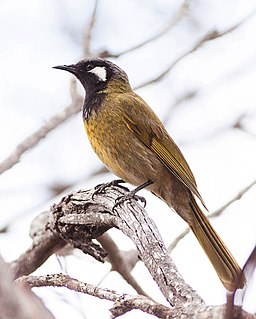Related Research Articles

The paradise parrot, species Psephotellus pulcherrimus, was a colourful medium-sized parrot native to the grassy woodlands of the Queensland – New South Wales border area of eastern Australia. Once moderately common within its fairly restricted range, the last live bird was seen in 1927. Extensive and sustained searches in the years since then have failed to produce any reliable evidence of it, and it is the only Australian parrot recorded as disappearing and presumed extinct.

The stone-curlews, also known as dikkops or thick-knees, consist of ten species within the family Burhinidae, and are found throughout the tropical and temperate parts of the world, with two or more species occurring in some areas of Africa, Asia and Australia. Despite the group being classified as waders, most species have a preference for arid or semi-arid habitats.
Gregory Macalister Mathews CBE FRSE FZS FLS was an Australian-born amateur ornithologist who spent most of his later life in England.

Johannes Gerardus Keulemans was a Dutch bird illustrator. For most of his life he lived and worked in England, illustrating many of the best-known ornithology books of the nineteenth century.

Gallinago is a genus of birds in the wader family Scolopacidae, containing 17 species.

Psephotellus is a genus of four species of Australian parakeets. All species show considerable sexual dimorphism. These species have traditionally been placed in the genus Psephotus along with the red-rumped parrot, but a molecular study analysing nuclear and mitochondrial DNA found that the red-rumped parrot was an early offshoot in a clade of several genera of broad-tailed parrot, with the other species nested deeply within.

The western rosella, or moyadong, is a species of parrot endemic to southern Western Australia. The head and underparts are bright red, and the back is mottled black; a yellow patch at the cheek distinguishes it from others of the genus Platycercus. Adults of the species exhibit sexual dimorphism with the females duller overall; juveniles lack the striking colours of mature birds and the characteristic patterning is not as easily distinguished. Their communication call is a softly delivered pink-pink sound, and much of their behaviour is comparatively unobtrusive. Their habitat is in eucalypt forests and woodlands, where they often remain unobserved until they appear to feed on seeds at nearby cleared areas.

The varied lorikeet, is a species of parrot in the family Psittacidae that is endemic to the northern coastal regions of Australia.

The black honeyeater is a species of bird in the honeyeater family Meliphagidae and the sole species in the genus Sugomel. The black honeyeater exhibits sexual dimorphism, with the male being black and white while the female is a speckled grey-brown; immature birds look like the female. The species is endemic to Australia, and ranges widely across the arid areas of the continent, through open woodland and shrubland, particularly in areas where the emu bush and related species occur.

The White-breasted Robin is a passerine bird in the Australasian robin family Petroicidae and the Yellow Robin genus Eopsaltria. Occasionally it is placed in the genus Quoyornis. It is endemic to southwestern Australia. Unlike many other Australian robins, it lacks bright colours in its plumage, being a predominantly greyish bird with white underparts. Like other closely related Australasian robins, it is a cooperative breeder. It is sedentary, with pairs or small groups maintaining territories.

The white-fronted honeyeater is a medium-sized bird species endemic to Australia. Mainly distributed throughout arid and semi-arid landscapes. The white-fronted honeyeater has distinct colourings with a white face, black or brown upper chest with white speckles and yellow panels on their brown wings .

Tregellasia is a genus of birds in the family Petroicidae that are found in Australia and New Guinea.

The western wattlebird is a passerine bird in the honeyeater family, Meliphagidae. It is restricted to south-western Australia.
The Birds of Australia is a 12-volume ornithological handbook covering the birds of Australia. It was the second of three monumental illustrated works dealing with the avifauna of the continent and was published midway between the other two, the first being Gould's identically titled The Birds of Australia (1840-1848), and the third the Handbook of Australian, New Zealand and Antarctic Birds (1990-2006).
Sidney William Jackson was an Australian naturalist and field ornithologist with a special interest in oology, who was also a skilled photographer and taxidermist.

The Urrao antpitta, also known as Fenwick's antpitta, is a highly threatened species of bird found in the understory of cloud forest in the Andean highlands of Colombia. The first published description used the scientific name Grallaria fenwickorum ; shortly afterward, a second description using the name Grallaria urraoensis was published. The editors of the latter recognized that the name likely was a junior synonym, but others have questioned the validity of the first description, and various authorities, including the International Ornithological Congress, have adopted G. urraoensis. Antioquia antpitta has been suggested as an English-language name compromise.

Carterornis is a genus of birds in the family Monarchidae that are found in Australia and Melanesia.

Spilopelia is a genus of doves that are closely related to Streptopelia, yet distinguished from them by differences in morphology and behavior. Some authors have argued that Stigmatopelia is the valid name as it appears in an earlier line although also erected by the Swedish zoologist Carl Sundevall, but Richard Schodde and Ian J. Mason in their zoological catalogue of Australian birds chose Spilopelia citing clause 24(b) of the International Code of Zoological Nomenclature (ICZN) which supports the decision of the first reviser. The name Spilopelia combines the Ancient Greek spilos meaning "spot" and peleia meaning "dove".

Nesoptilotis is a genus of honeyeaters endemic to Australia and Tasmania. The genus consists of two former members of Lichenostomus, and was created after a molecular phylogenetic analysis published in 2011 showed that the original genus was polyphyletic.
Frederick Bulstrode Lawson Whitlock (1860-1953) was an ornithological writer and oölogist, active in England and across Western Australia.